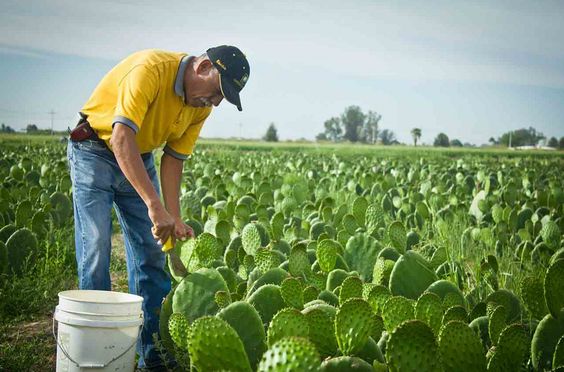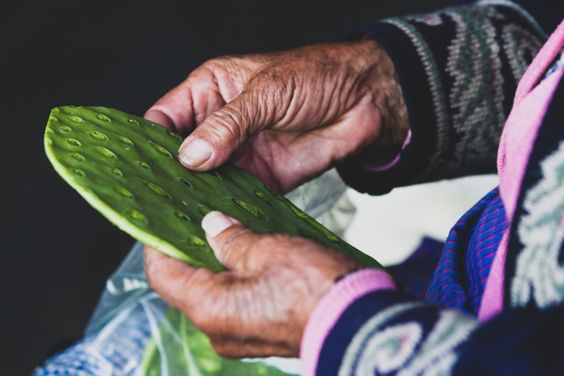
There are many substitutes available for real leather and they are often called vegan leather or imitation leather. One such alternative that is making headlines these days for its exceptional qualities is cactus leather.
Cactus leather is a relatively new addition to the family of faux leathers. In this article, we will discuss this magnificent material and try to answer all your questions about it like what is cactus leather? How cactus leather is made? What makes it so special?
Table of Contents
What is cactus leather?
Cactus leather is a kind of faux leather and also known as Desserto, is an innovative and sustainable alternative to animal leather.
Cactus leather is derived from the leaves of cactus as raw material. It is made from Nopal cactus (scientific name: Opuntia ficus-indica) which is known for its high resilience and low water requirements, making it an eco-friendly substitute to other materials.
How cactus leather is made?
The cactus leather production process consists of various environmentally friendly steps that transform it from a desert plant into a sustainable material for various uses. The entire production process is highly sustainable, as the cactus requires very little water and the use of non-toxic chemicals. Here is a detailed overview of the production process
1.| Cactus cultivation
The Nopal cactus (Opuntia ficus-indica) is indeed cultivated mainly in farms in Mexico. It thrives in dry environments and requires minimal water and artificial fertilizer.
2.| Cactus leaves Harvesting

The mature cactus leaves which are called paddles, are harvested without damaging the plant, which will continue to grow and will be ready for reuse in 6-7 months.
3.| Cleaning the leaves

After the cactus paddles (leaves) are cleaned of dirt and impurities by rinsing them in water tanks before removing thorns for further processing.
4.| Processing
Clean cactus leaves are processed by mashing them into a pulp. In some cases, a shredder may also be used to shred them before further processing.
5.| Drying
The cactus pulp undergoes a drying process where it is laid out under the sun for 3-4 days. This process reduces the moisture content to the desired levels, making it suitable for further processing.
6.| Blending
Now comes the most crucial step which is blending. The partially dried cactus pulp is mixed with non-toxic binders and other eco-friendly chemicals to form a bio-resin. This bio-resin is skillfully formulated to achieve the desired properties of cactus leather.
7.| Leather sheet making
The bio-resin prepared in the previous stage is spread onto backing material such as cotton or polyester to create sheets of cactus leather with the desired thickness in mind.
8.| Finishing
In this step, the prepared cactus leather sheets undergo various surface-enhancing procedures such as embossing, polishing, coloring, and adding protective coatings.
Environmental benefits of cactus leather
There are indeed many environmental benefits of using cactus leather over other types of faux leather. Cactus leather is highly sustainable and eco-friendly. Cacti require very little water to grow compared to the vast amounts needed for raising livestock for animal leather, and the environmental impacts of PU leather are also concerning. Moreover, cactus can be harvested without damaging the plant, which can be regrown and reused again.
Unlike other types of leather, cactus leather doesn’t require any harmful chemicals in its production, and it is also biodegradable, making it highly eco-friendly.
Cactus leather is also very durable and breathable in nature, so it doesn’t require frequent replacements. Additionally, it is a suitable material for those who are concerned about animal welfare, as it’s a plant-based material and doesn’t involve any kind of animal cruelty.
Fashion brands leading the way with cactus leather
Many world-renowned fashion brands are incorporating cactus leather into their products, including Mercedes-Benz, H&M, Fossil, Adidas, Stella McCartney, Pangaia, Lifestyle, Canopy Verde, Matt & Nat, Deux Mains, Nopalera, Thamon, and many more.
These brands represent just a few examples of the evolving trend toward sustainable fashion materials and accessories in the industry.
Uses of Desrerto cactus leather
The cactus leather is a versatile material and can be used where traditional leather can be used like handbags, clothing, shoes, upholstery, automotive interiors, accessories, and many more.
Conclusion
In conclusion, when asked about my thoughts on leather and its alternatives, I would say that real leather holds a special charm that cannot be replicated by any artificial material. Leather’s natural essence and the uniqueness of each skin give it an irreplaceable character. While cactus leather is a sustainable option, can it replace real leather? In my view, nothing can replace the authenticity of natural leather. However, cactus leather is well-suited for regions abundant in cacti, and its production can offer significant economic opportunities in those areas.
I’ve shared my thoughts and knowledge about cactus leather and tried my best to answer the question “What is cactus leather?” However, choosing between real leather and cactus leather is ultimately a personal decision.
For more information on leather products, you can check our other articles or you can contact us. LeatherBlues is known as one of the best stores for real leather products. Explore our amazing collection of leather garments and services.
Related topics: What is PU leather? 10 good reasons to choose
